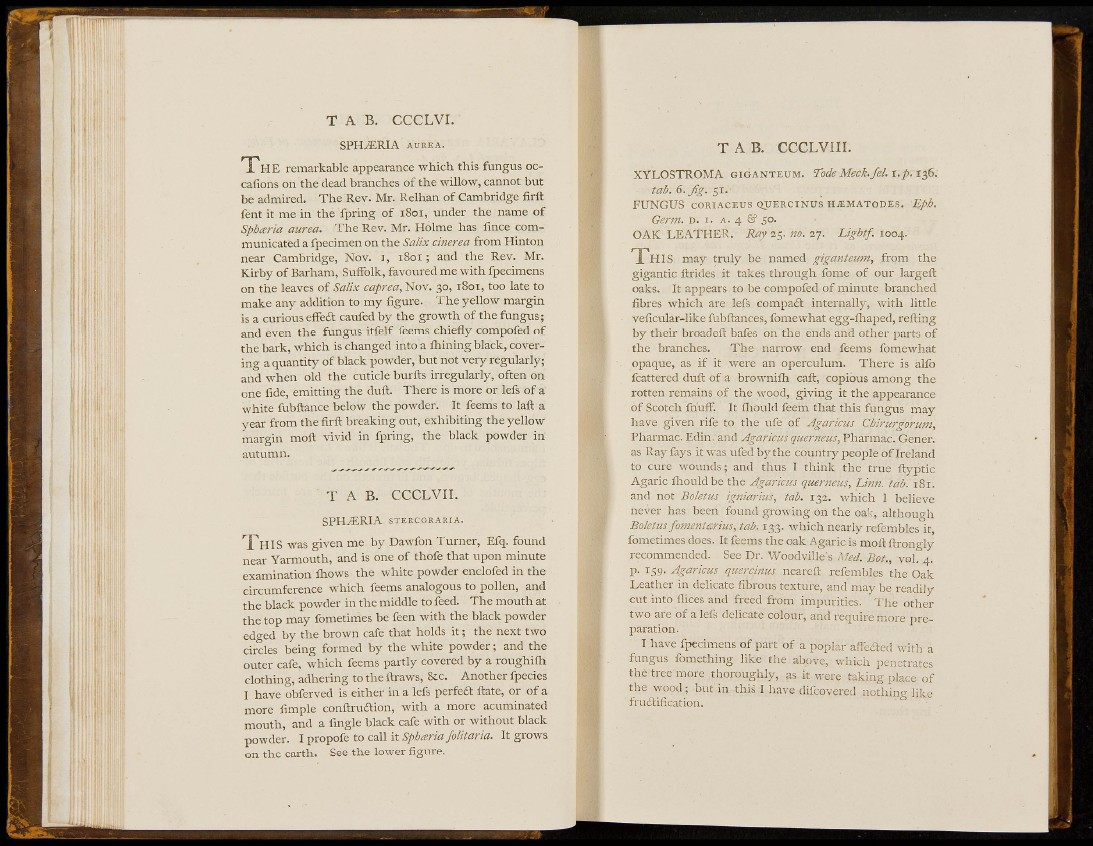
T A B . CCCLVI.
S P H J E R I A AUEEA.
T H E remarkable appearance which this fungus occafions
on the dead branches of the willow, cannot but
be admired. The Rev. Mr. Relhan of Cambridge firft
fent it me in the fpring of 1801, under the name of
Spharia aurea. The Rev. Mr. Holme has fmce communicated
a fpecimen on the Salix cimrea from Hinton
near Cambridge, Nov. 1, 1801 ; and the Rev. Mr.
Kirby of Barham, Suffolk, favoured me with fpecimens
on the leaves of Salix caprea, Nov. 30, iSoi, too late to
make any addition to my figure. The yellow margin
is a curious effeft caufed by the growth of the fringus;
and even the fungus itfelf feems chiefly compofed of
the bark, which is changed into a ihining black, covering
a quantity of black powder, but not very regularly;
and when old the cuticle burils irregularly, often on
one fide, emitting the duft. There is more or lefs of a
white fubftance below the powder. It feems to lafl a
year from the firft breaking out, exhibiting the yellow
margin mofl vivid in fpring, the black powder in
autumn.
T A B. CCCLVII.
S P H A R I A STEHCORARIA.
T H I S was given me by Dawfon Turner, Efq. found
near Yarmouth, and is one of thofe that upon minute
examination ihows the white powder enclofed in the
circumference which feems analogous to pollen, and
the black powder in the middle to feed. The mouth at
the top may fometimes be feen with the black powder
edged by the brown cafe that holds it; the next two
circles being formed by the white powder; and the
outer cafe, which feems partly covered by a roughiih
clothing, adhering to the Ifraws, &c. Another fpecies
I have obferved is either in a lefs perfeft ftate, or of a
more fimple conftruftion, with a more acuminated
mouth, and a fmgle black cafe with or without black
powder. I propofe to call it Spharia Jolitaria. It grows
on the earth. See the lower figure.
T A B . CCCLVIII.
XYLOSTROMA GIGANTEUM. TodeMeek.fell.p.
tab. 6. Jig. ¡1.
FUNGUS coRiACEUs QUERCINUS H^MATODES. Eph.
Germ. D. I. A. 4 © 50.
OAK LEATHER. Ray 25. no. 27. Lightf. 1004.
T H I S may truly be named giganteum, from the
gigantic ftrides it takes through fome of our largeft
oaks. It appears to be compofed of minut e branched
fibres which are lefs compait internally, with little
veficular-like fubitances, fomewhat egg-ihaped, refting
by their broadeft bafes on the ends and other parts of
the branches. The narrow end feems fomewhat
opaque, as if it were an operculum. There is alfo
fcattered duft of a brownifli caft, copious among the
rotten remains of the wood, giving it the appearance
of Scotch fn'uff. It fliould feem that this fungus may
have given rife to the ufe of Agaricus Cbirurgorum,
Pharmac. Edin. and Agaricus querneus, Pharmac. Gener.
as Ray fays it was ufed bythe country people of Ireland
to cure wounds; and thus I think the true flyptic
Agaric iliouldbe the Agaricus querneus, Linn. tab. 181.
and not Boletus igniarius, tab. 132. which 1 believe
never has been found growing on the oak, although
Boletus fomentarius, tab. 133. which nearly refembles it,
fometimes does. It feems the oak Agaric is moftftrongly
recommended. See Dr. Woodville s Med. Bot., vol. 4.
p. 159. Agaricus quercinus nearelt refembles the Oak
Leather in delicate fibrous texture, and may be readily
cut into flices and freed from impurities. The other
two are of a lefs delicate colour, and require more prepai'ation.
I have fpecimens of part of a poplar affeited with a
fungus fomething like the above, which penetrates
the tree more thoroughly, as it were taking place of
the wood; but in this I have difcovered nothhig like
fruilification.